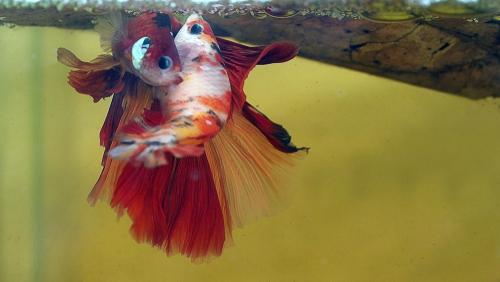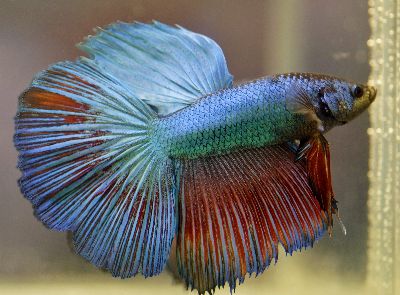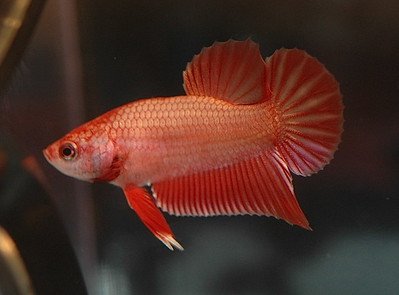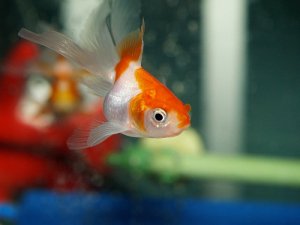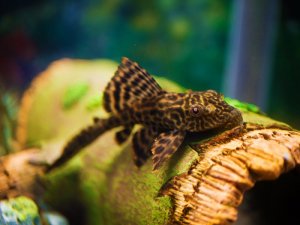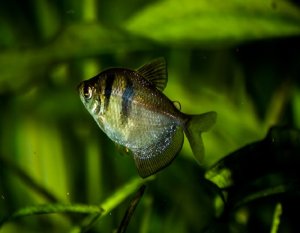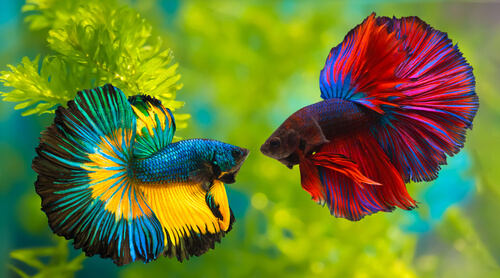
As we all know, two male Betta Fish are sure to fight and kill each other if put together, however, the question often arises whether a male and female Betta Fish can be kept in the same tank.
Unfortunately, there is no short answer here, it is highly discouraged to keep a Male and female Betta Fish together in the same tank, unless for a short period for breeding. On very rare occasions, in large tanks, you might get away with housing them together, depending on their individual personalities.
Species Information
If you look at the History of the Betta Fish, or “Siamese Fighter” as many of us know them as they were bred and used for their aggression. Betta Fish originated in Thailand where they were domesticated and bred as “Fighting Fish” for gambling games.
Betta Fish are freshwater, carnivorous fish that originate from Southeast Asia, they are endemic to Thailand and were domesticated more than 1000 years ago. They rarely grow larger than 3 inches in size, and they are available in a vast array of colors and finnage variations.
Betta Fish, especially males are usually housed alone, and solitary, though some do enjoy some tank mates that are other species, which you can read about further along. Females can be housed together, though only in groups of four or more, as two females will fight and one will dominate the other.
Distinguishing Between Male And Female Betta Fish
| Male Halfmoon Betta Fish
|
Female Halfmoon Betta Fish.
|
| Color | |
| Your males have brighter and more vibrant colors, and that is why most pet stores usually mainly sell male Betta Fish. They likewise do not display stripes. | The females will have much more subdued colors. However, during mating conditions their colors will darken, and they will develop stripes. |
| Tail And Fins | |
| Though there are different Finnage Variations, Males usually have longer and thicker fins. | Females generally have shorter and thinner fins and an especially shorter Caudal fin. |
| Body Shape | |
| Males have a slender body that is long and narrow. | Females have a much shorter and wider body shape. |
| Size Difference | |
| Fully grown males can be between 2.5 to 3 inches. | Fully grown females may be between 2 to 2.5 inches, slightly smaller. |
| Egg Spot | |
| Males do not have an Egg Spot. | The females have a white dot between their ventral and anal fin that is tiny and hard to see. It is used to deposit her eggs during spawning. |
| The Betta Beard | |
| Males have large Beard, that is easily visible, even without them flaring. | Females generally have a small beard which is slightly visible when they flare. |
| Behavior | |
| The male Betta will Flare its gills to display aggression to show dominance and to wear off intruders, many times their own reflection. Male Betta Fish are extremely aggressive toward other males and can be aggressive toward other fish species, especially those with trailing fins. | The Female will flare at other females in her Sorority to indicate that she is dominant. The female will also position her head down when flaring. Very interesting, did you know females are only aggressive in pairs, but not when kept in a community of four or more. |
| Breeding | |
| The Male Betta Fish creates a bubble nest and will care for the eggs and hatchlings until they are independent. Males may also create a bubble nest even if they are without a female. | Females rarely create bubble nests, and they only lay the eggs for fertilization, before being chased off by the males. |
Now that you know the critical differences between male and female Betta Fish, we can look a bit further into why you cannot ideally keep them together, and a few ways in which you could attempt to keep them together.
Can Male And Female Betta Fish Live Together?
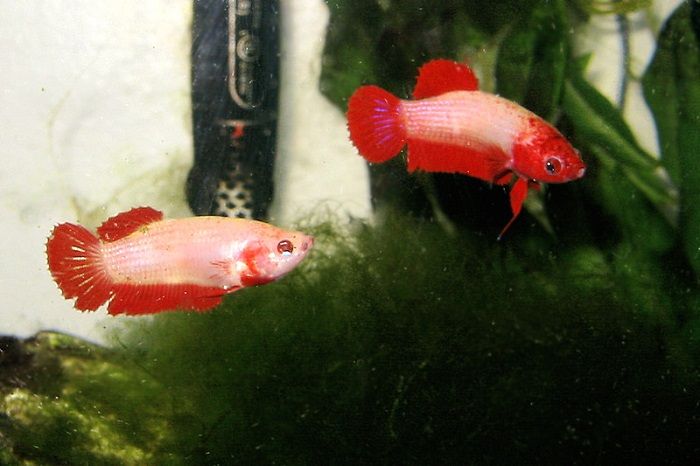
In very rare cases male and female Betta Fish can be kept together in the same tank, though it is highly discouraged. Male and female Betta Fish are paired up and kept together for breeding purposes only, and the female is then usually taken away after laying eggs. Two male Betta Fish can never be kept together as they will fight to the death.
1. Why You Should Not Keep A Male And Female Betta Together
Male Betta Fish are aggressive and territorial; thus, they will attack any fish, especially their own female species that comes near their territory or hiding space. Aggression between females only arises to assert dominance creating what we call a Pecking Order.
Female Bettas kept in the same tank as males may get stressed out quickly which could affect their health, and prevent them from laying eggs.
2. Keeping A Male And Female Betta Fish In The Same Tank Long Term
Though I highly discourage it, there is a small possibility that you can keep a male and female Betta Fish together in the same tank, provided that it is a large tank that has plenty of accessories, plants, and hiding places.
You will need a tank size of at least 15 gallons, and 5 gallons extra for every additional Betta Fish you want to keep. In a situation where male and female Betta Fish are kept in the same tank, it is highly unlikely that they will breed or get along.
1. Plants And Ornaments To Add To Your Tank;
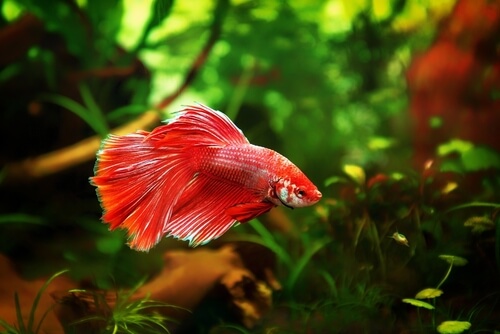
- Substrate – For any tank you will need a good substrate to place at the bottom of the tank. Sand and gravel are your best options.
- Synthetic Plants – Silk and softer types of synthetic plants can be used, especially floating plants.
- Live Plants – Live plants are ideal, and you can choose bottom or floating live plants. Floating Live plants encourage your Male Betta to create bubble nests should there be a slight chance that they may breed. Amazon Frognit, Red Root Floaters, and Sprites are ideal floating plants. While, Anubias, Java Ferns, Marimo Moss Balls, Betta Bulbs, Amazon Sword Plants, and Vallisneria are excellent choices for stationary plants.
- Ornaments and Hiding Spaces – Anything that the Betta Fish can hide in such as caves, castles, shipwrecks, or bridges are ideal. You can also add Rocks and driftwood to your tank in such a manner as to create hiding spaces.
2. Water Conditions
Betta Fish need fresh water in their tank with a neutral pH of 7.0 or more. They are tropical fish so a heater may be required to maintain temperatures of around 24 – 28 degrees Celsius (75 – 82 Degrees Fahrenheit)
3. Introducing Male And Female Betta Fish
It is best to keep a single male Betta Fish with a sorority (group) of female Betta Fish, though you can house a single female with a single male. In the case where you have a sorority of females, they should be placed in the tank first and kept until they have established a hierarchy and selected territories so that there is no fighting amongst females.
After this, you will need to rearrange the tank to break down all territories, before adding the male, to keep the females busy re-organizing so that the male can scout out his new home.
Always add your female to your tank first and allow her enough time to adjust. Let the male float in its bag for a while to allow them to get to know each other, or keep the male in a separate container, or divider inside, or next to the tank. If you do not notice any signs of aggression, you can introduce the male to the tank. This may take a few days though.
If aggression of any kind occurs, it is much better to separate the fish, and to before an injury occurs.
3. Using A Divided Tank
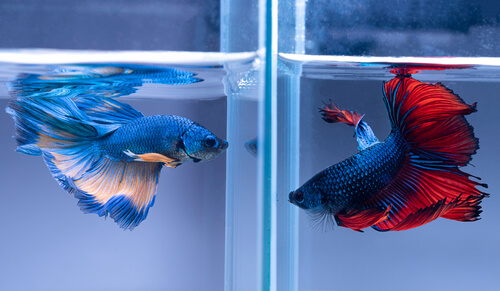
A much better way of housing male and female Betta Fish together of course is to use a divided tank, keep in mind females need much more space as they enjoy swimming space more than males. The tank size for females should be almost double of that needed by males.
4. Keeping Male And Female Betta Fish Together For Breeding
If your purpose is to breed your Betta Fish, and not cohabitate with them, then the process will be quite different. You will need a separate breeding tank with no ornaments or substrate and plenty of floating plants or almond leaves.
Place the female in the tank first and allow her to get used to the environment for a day or two. Place the male in a separate container or divider inside or next to the tank. If there are no signs of aggression, such as flaring, you can add the male to the tank. The male will build a bubble nest, which the female will inspect and ignore, in which case you should remove her from the tank.
If she accepts the bubble nest they will mate, where the female will lay her eggs and the male will place them in the bubble nest. After the process the female needs to be removed. The male takes care of the eggs and hatchlings, until they become more independent, in which case you will need to separate them. You can read more about mating and breeding on our site “Your Aquarium Place”.
The Best Tank Mates For Betta Fish
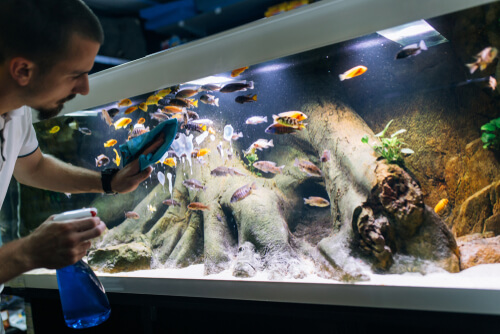
If all else fails and you do not succeed in cohabitating with male and female Betta Fish, or maybe after what you have read you changed your mind, why not opt for a safer option, such as tank mates of another species of fish?
Though still risky, it is quite rare for male or female Betta Fish to attack and kill tank mates that are another species, provided that you take care in selecting tank mates that are suitable for living with a Betta Fish.
Selecting Tank Mates
There are generally a few types of fish species and invertebrates that male and female Betta Fish will get along with quite well, keep in mind that you will need ample tank space and hiding spaces for the territorial Betta. Though you can get away with a much smaller tank, than what you would need to keep a male and female Betta Fish in.
Peaceful, tropical communal fish that shoal, and that are not territorial are ideal. Avoid colorful fish with long flowing fins that could be inviting for a Betta Fish to nip at, as well as other aggressive species that may harm your Betta Fish.
Here are some excellent choices in tank mates for Betta Fish;
- Tetras – They are peaceful and shoal in large groups.
- Loaches – A bottom-feeding scavenger fish that is peaceful, and will help to keep your tank clean.
- Rasboras – Colorful and too fast for the Betta to get hold of, providing them with much-needed exercise and enrichment.
- Corydoras Catfish – An easy-going bottom feeder that will also clean your tank. They come in a few color varieties and generally keep to themselves.
- Danios – Also a fast fish that is peaceful and available in many colors. They should be kept in larger groups though, and they do tend to shoal.
- Malaysian Trumpet Snail – These snails are nocturnal and will burrow in your substrate during the day. They work hard to keep your tank clean, which is an added bonus.
To Conclude:
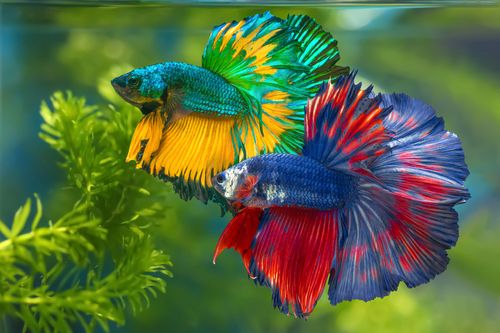
In very rare circumstances, under the right conditions, and in large tanks Male and female Betta Fish can live together, depending on the individual personalities, or temperament of the fish. However, it is a much better decision to opt for other species of fish as tank mates from your Betta Fish. Females can be kept together, with the exception that they are kept in groups of four or more females, and never just two females.

